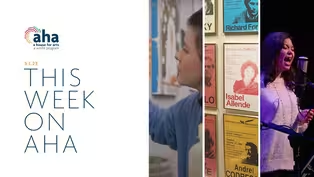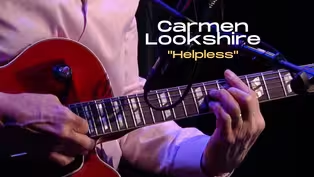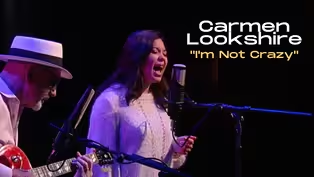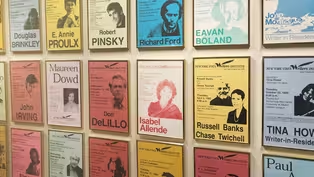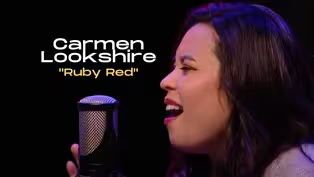
AHA! | 820
Season 8 Episode 20 | 28m 45sVideo has Closed Captions
Enjoy a rich exploration of cultural identity through art, literature, and music.
AHA delves into the intersection of culture and creativity. Artist Arnela Mahmutović shares how she blends her traditional upbringing with Western society in her artwork. Paul Grondahl, Opalka Endowed Director of the NYS Writers Institute, discusses the Institute's history and its Visiting Writers Series. Musicians Carmen Lookshire and Joseph Carrick perform "Ruby Red" from their album For Love.
Problems playing video? | Closed Captioning Feedback
Problems playing video? | Closed Captioning Feedback
AHA! A House for Arts is a local public television program presented by WMHT
Support provided by the New York State Council on the Arts (NYSCA), M&T Bank, the Leo Cox Beach Philanthropic Foundation, and is also provided by contributors to the WMHT Venture...

AHA! | 820
Season 8 Episode 20 | 28m 45sVideo has Closed Captions
AHA delves into the intersection of culture and creativity. Artist Arnela Mahmutović shares how she blends her traditional upbringing with Western society in her artwork. Paul Grondahl, Opalka Endowed Director of the NYS Writers Institute, discusses the Institute's history and its Visiting Writers Series. Musicians Carmen Lookshire and Joseph Carrick perform "Ruby Red" from their album For Love.
Problems playing video? | Closed Captioning Feedback
How to Watch AHA! A House for Arts
AHA! A House for Arts is available to stream on pbs.org and the free PBS App, available on iPhone, Apple TV, Android TV, Android smartphones, Amazon Fire TV, Amazon Fire Tablet, Roku, Samsung Smart TV, and Vizio.
Providing Support for PBS.org
Learn Moreabout PBS online sponsorship(inspirational music) - [Jade] Explore the work of visual artists, Arnela Mahmutovic.
Paul Grondahl discusses the importance of the Writer's Institute.
And catch a performance from Carmen Lookshire.
It's all ahead on this episode of "AHA, A House for Arts."
- [Narrator] Funding for AHA has been provided by your contribution and by contributions to the WMHT Venture Fund.
Contributors include the Leo Cox Beach Philanthropic Foundation, Chet and Karen Opalka, Robert and Doris Fisher Malesardi, and the Robison Family Foundation.
- At M&T Bank, we understand that the vitality of our communities is crucial to our continued success.
That's why we take an active role in our community.
M&T Bank is pleased to support WMHT programming that highlights the arts and we invite you to do the same.
(inspirational music) (inspirational music continues) - Hi, I'm Jade Warrick and this is "AHA, A House for Art," a place for all things creative.
Here's Matt with today's fill segment.
- I'm in at Albany, New York to visit with artist Arnela Mahmutovic.
Let's go.
(upbeat music) - I am a first generation Bosniac-American and my family came over about 23 years ago from Eastern Europe, specifically from a region called Sanjak, which borders a few countries.
We essentially fled, because that area and that region was not safe anymore.
I spent most of my life kind of balancing these two parts of myself and there's a lot of responsibility, I think as a child of immigrants, to on one hand, preserve this culture and tradition that your parents carry, and on the other end, you are trying to assimilate and adapt to the world that's around you.
And that definitely finds its way into the work.
This dual identity, and trying to compare and contrast these two sides of myself.
So, I see my paintings as these products of a disjointed history.
So, most of them are compiled with multiple different elements that I source from a variety of places.
And sometimes, that can just be material alone.
So I can try to pair, you know, something very, very traditional and old, like oil painting alongside a newer medium or maybe a new technique or approach.
I also incorporate drawing a lot into my practice, and there's this contrast between the soft and slow act of painting with this very fast, rigorous and sort of agitated nature of drawing.
And then on the other end, there's this imagery that I tried to pair, to ultimately create some type of harmony, but most of the time it doesn't work, because the images weren't found together and maybe aren't supposed to exist together.
And some of that imagery is specifically pulled from eastern miniature painting, Islamic manuscripts.
So you'll find borders, pattern, this sort of collapsing of perspective alongside a very rendered and molded figure that maybe aligns more closely to Western rules and ideals within painting.
Figure or figuration in my paintings is I think the core of it all.
And I, of course, have fun thinking about pattern and color and composition, but without figure, I don't think I would enjoy painting as much as I do.
For me, the body is the closest and most immediate way to translate a story.
So, no matter what the figure is we immediately feel some type of closeness to it.
Maybe the figure can act as a vessel for someone else to maybe place themselves in that environment.
There's always this veiling that encapsulates them.
And that veiling has a few different references.
One is a more religious reference and the other is that it acts as this anonymous barrier, where you can't place the figures in a specific time, where I like the fact that they feel like maybe they were created a hundred years ago or yesterday or at some point in the future.
For a while, I really didn't know how to identify.
And I was really rejecting this traditional aspect of my life and really the Bosniac part of myself, because it didn't fit in anywhere.
I mean, I ate different food, I had this other language I had to speak.
There were rules and sort of regulations that my parents had in place, right, to sort of maintain some type of order for them, right?
And it took a long time for me to make peace with the thought of them existing or coexisting with one another.
And that really didn't happen until I found art and making as a way to deal with a lot of those difficulties.
A recent piece that I'm working on centers food and the importance of food in, I think many cultures, but specifically Bosniac-American households and how it acts as this connecting factor and a means for preservation.
So, when we think about families that were displaced or finding themselves in a new environment, food is a way to sort of transport them to something familiar.
And to pass it down.
I think a lot of parents who move to another country have very, very high expectations of what their children will end up doing.
So, they kind of ideally would like for us to go into a medical field, maybe something that has money on the other side of it.
And my parents were very skeptical at the beginning, but as soon as I started going to college I think they noticed a shift or a change in me, where it went from this frustrated teenager, who was like rebelling and I don't know, talking back to a more levelheaded person who found a goal, right?
They found this structure in painting, in learning.
And I think that spark in me is what helped them understand that this was important.
I mean, and now it's just a part of my life.
I think they are completely accepting and maybe they don't understand everything.
I don't think they get most of the paintings, that's totally fine.
But I think they know that I have a deep, deep connection and love for the culture that I'm trying to get across somehow.
And that means a lot to them.
To be making images and art that can resonate with someone else who's either gone through the same journey that I have or maybe is parallel to my journey or is experiencing something similar.
That's incredibly beautiful and it's a privilege to be able to experience that through making.
- The New York State Writer's Institute was founded in 1983 by Pulitzer Prize winning author William Kennedy.
It has since hosted over 2,000 guests as part of its visiting writer series.
Today I'm excited to be joined by the Institute's Opalka endowed director Paul Grondahl.
Hi Paul, welcome to AHA.
- Thank you, Jade.
It's great to be here.
- Awesome.
Well, I'm excited to talk to you about not only the New York State Writer's Institute, but to get to know a little bit more about yourself.
To start, how did you get into journalism?
- It's a weird story and a long story.
I work with a lot of students, journalism classes and I tell 'em up front, I'm honest, I never took a journalism class.
I'm an English literature major, undergraduate, graduate school.
I got used to rejection, which is a great part of the job as a journalist.
I got rejected probably a couple hundred times when I sent out resumes to newspapers, 'cause I didn't have a journalism degree.
I kept pestering the Albany Times Union and on my third try, the great, late legendary editor Harry Rosenfeld gave me a shot.
So, I started on "Night Police" in 1984.
- [Jade] Awesome.
- Long before you were born, I'm sure.
- (laughs) Just a little bit, just a little bit.
- I'm going back to ancient history.
- So, what is "Night Police?"
Is that like a night crawler - - It's like a night crawler.
You know, I was just out of graduate school.
I had worked at my hometown newspaper in Tacoma, Washington through college.
I had work study, first generation college student, proud of that.
So, I had a little bit of skills, but I had not covered hard news.
So, they sit you near the police scanner and nothing good happens, as you know, after 1:00 AM or 2:00 AM.
And it was always tragedy.
Shootings, fires, explosions.
I remember on the, probably the third day I was there in 1984 in the summer, I started in August, got a call and when you start hearing multi-company called in emergency squads, you know it's bad.
So, it was out near Hoosick Falls, Route 7, convertible, young woman, 19 years old, carrying nieces, nephews, neighbors, bunch of little kids back from an ice cream thing hit a tree at full speed.
And you get out there and they're picking up little children from a field and you realize, you know, why are you there to tell a story, but a horrific, sad human story.
So, the first thing I learned is to be a person and a journalist with a capital J second.
And I've seen on so many scenes like that, no offense to TV people, but sometimes they come in with hot lights and a hot mic.
And I would treat the way I would want to be treated at the worst moment.
You know, I sat with families where their son or daughter was just bleeding out.
I sat in kitchens with kids who had just overdosed.
And when you see kind of the worst of humanity, but the beauty is it's the moment where they want to share the story of the loved one that they just lost in some horrible, traumatic way.
And that gives you empathy, I think and gives you an insight into human condition.
And then, you know, I've probably done 10,000 stories for the Times Union and you try to leven it up with happy ones.
I know you're a happy person when I see you, you're always smiling and laughing, so there's heavy parts but you try to leven it up with some fun stories, too.
- So does a lot of, well, what does your work usually focus on?
Like, what are your themes?
- I like human interest stories, in particular people stories.
You know, stories about like the underdog, someone overcoming a terrible illness or from the ground up.
I like people, you know, who are first generation college students.
Students didn't came up the hard way.
I like stories that sort of have an unexpected twist.
So, I also did long projects on domestic violence, homelessness, mental illness, prison issues.
And you take on those big subjects and you sort of have to find real people.
So it's always about the humanity, the real people behind it.
And that's what I like about storytelling.
- And do you think like your experience within, being a night crawler with the night police, like that kind of led you to being this more empathetic, you know, people first type of journalist?
- Absolutely.
Because when you see people at their most vulnerable and after they've just experienced a trauma, you sort of realize that you're there first to do no harm.
I mean, journalists do take a kind of Hippocratic Oath.
And the other thing that always stuck with me, even though I didn't take a journalism course, I sat next to a really good journalist, really quality journalist and I learned kind of an apprentice.
And it was the saying, "Comfort the afflicted and afflict the comfortable," it's perfect advice.
So we do a lot of investigative work, go after, you know, bad corporate entities or corrupt business people or corrupt politicians.
That's a big part of journalism too.
- Yeah, and that's very important, because journalists really do lead the way.
- Yeah, the fourth estate, you know, we're supposed to be the voice and ears of the people.
So, I like to write about people that don't have a voice, kind of the voiceless, but we also like to hold accountable people with great power and people with great privilege.
So it is an honor to be a journalist.
That's why I still write a weekly column for the Times Union, even though it's been six years, I've been gone six years at the Writer's Institute, so.
- Oh, wow.
Well, thank you for doing the good work.
(laughs) And every journalist out there.
- It is a pleasure.
You know what I mean?
I mean it's storytelling, it's seeing really interesting people.
People say like, "Why don't you write about yourself?"
I said, "I'm not that interesting.
I'm average."
There's so many more interesting people out there that have done beautiful things, you know.
- Cool.
So, I know you're the executive director of the New York State Writer Institute?
Correct?
- Yes.
Just director.
But I actually have a new title, the Opalka Endowed Director.
Just in the last couple weeks it was announced that Chet and Karen Opalka, who are generous philanthropists specifically for the arts, endowed a directorship in my name, a $1 million directorship that will go to in perpetuity.
So, every year there will be money available to my successor and the next successor after me to fund really diverse, interesting program.
So, it's an endowment that never runs out, which is a beautiful thing.
- That is amazing.
Go Opalka.
- They're wonderful people.
So, I am the Opalka Endowed Director.
Officially, in the last two weeks, yes.
- Well, congratulations.
- Thank you.
- Well, so give us a little bit about the New York State Writer's Institute, for folks who don't know.
- So, we were founded, this was the big announcement two weeks ago, start of our 40th season.
Chet and Karen Opalka were there.
We announced this gift, it was just beautiful.
But we're 40 years, we are founded by William Kennedy.
He used some of his MacArthur Genius grant money to fund.
He always wanted to bring world class writers in every genre, from many countries, to our campus and to Albany.
And that's what we've done for 40 years.
We've had over 2,500 writers, Nobel Prize winners, Pulitzer Prize winners, Booker Prize winners, the greatest writers in every genre and every kind of diversity you want to measure.
So, it's been a wonderful thing and we keep it free and open to the public, as generous people like Opalkas and our sponsors.
We don't charge ticket prices, which you would find in most cities.
Like 92nd Street Y in New York City has a lot of the same authors and it'll cost you a lot of money to go there.
So, we present this free and open to the public, 'cause of our sponsors.
So, it's a wonderful thing.
- And very accessible.
So, why do you think the Writer's Institute is important for the writer's community, besides it being accessible?
- So, we also hold free workshops.
We do them in person, we do them online now to be acceptable, I mean more accessible, sorry, to people.
And we also have a film festival coming up on April 1st, open to young filmmakers.
We do a short film competition.
We have a special category for students, which we love to get students involved.
We have a book festival, we have all the local writers come talk about their books, sell their books.
So, we really sort of cultivate support and enhance the local writing community.
And they're invited and involved on every level of what we do from volunteering to being on stage with our visiting writers, which is great fun.
- That is.
And what's been your favorite event so far within your history of this?
- Oh, we've done so many.
I mean, one of the great events, I got to interview on stage Supreme Court Justice, Sonia Sotomayor.
- Oh, I loved that!
- After about three minutes she said, "Do you mind if I walk around?"
I said, "You're the Supreme Court Justice.
I'm not gonna say no."
She had a wireless mic.
She walked all over SEFCU Arena.
They were like 5,000 people there.
She was pausing for selfies, hugging people, I mean a real pro.
And there's been so many, I mean, Salman Rushdie.
After the fatwa, so we waited 30 years to get him.
Unfortunately, he got attacked as you know, you know, this is serious, what's going on.
We're also doing sort of symposium, looking at these divisive issues right now.
And the ugliness that's also part of our dialogue and conversation in this country.
So we've also addressed a lot of that, with attacks on the free press.
People not being open and accepting of other viewpoints.
So we've also brought in authors that talk about that, as well.
- Now do you have any input within like, attack on the free press?
Because you're a journalist, so how do you handle that?
- We've actually hosted four major symposium, symposia, the plural, "Telling the truth in a post-truth world."
Started after President Trump was elected, what was going on with the press.
I mean, he called the press the enemy of the people.
And we don't take that lightly.
I think it was serious and a lot of people followed him in that thought.
- It's terrifying.
- So, anyway, very terrifying.
So, we've had a succession of those and most recently, we looked at hacking, cyber wars, bots.
And now with AI, the University of Albany where the Writer's Institute is based, and where I also teach, they're going heavily into AI, because that's also incredible opportunity, but a scary opportunity in terms of personal freedom, civil liberties, surveillance, you know, so the world's moving fast.
And we try to address it at the Writer's Institute, as well as time-honored classical poetry or literary fiction.
We also address current issues with current books and the greatest experts on every topic.
- Wow, so there really is a little bit of something for everyone.
- That's what, we love that, we had Melissa Gilbert, she had a memoir, "Little House on the Prairie."
We had kids from five and seniors to 85 in that audience.
And filled every seat in the house, 400 people.
And so we also, you know, we're not just all high brow.
We like to, when I started at the Times Union, this always stuck with me too.
The old timers who'd been there for a while, they called me "College Boy," 'cause I had a graduate degree in English, which is, doesn't really get you anywhere.
You have to learn to be a reporter.
But they called me "College Boy."
They said, "Remember, the people who buy this paper, the ads that support it, eighth grade reading level on average."
And I've never forgotten that.
You can't forget, you know, when you're on a college campus that you're on kind of a bubble.
And there's a lot of people who are struggling and I like telling those stories.
I like seeing what they're, you know, overcoming and dealing with.
We talked about the underdog story.
So, I always kind of remembered that, you know, PhDs in ivory tower is a small little slice of the world.
It's a big world out there.
And I try to reflect that in our stories and we reflect that in what we program at the Writers Institute.
- That's really a beautiful and amazing thing that you guys are doing.
And how do folks and writers get involved with the institute?
- Well, we've got a really dynamic website, nyswritersinstitute.org and you can follow us on all social media.
We have two or three events some weeks.
And we have a really busy schedule.
- Well, thank you Paul, and thank you for taking the time to talk to us today.
- It's great.
- I appreciate it.
- You've been a lot of fun.
Thank you.
- Please welcome Carmen Lookshire.
(soft guitar music) ♪ I feel helpless when you're not around ♪ ♪ It's like music ♪ ♪ It doesn't make a sound ♪ ♪ It's like mountains without trees ♪ ♪ Birds without the bees ♪ ♪ I'm helpless and hopelessly in love ♪ ♪ I miss your kisses ♪ ♪ Oh, and your gentle touch ♪ ♪ When I'm around you, I get oh, such a rush ♪ ♪ It's like the mountains without trees, ♪ ♪ Birds without the bees ♪ ♪ I'm helpless and hopelessly in love ♪ ♪ Why do I try to make it on my own ♪ ♪ With you by my side I know I can't go wrong ♪ ♪ It's like the mountains without trees ♪ ♪ Birds without the bees ♪ ♪ I'm helpless and hopelessly in love ♪ ♪ I'm so lonesome ♪ ♪ Without the scent of your perfume ♪ ♪ My life is boring ♪ ♪ Oh, without you lying in my room ♪ ♪ It's the things you do each day ♪ ♪ They make me wanna say ♪ ♪ I'm just helpless and hopelessly in love ♪ ♪ Why do I try to make it on my own?
♪ ♪ With you by my side I know I can't go wrong ♪ ♪ It's the things you do each day, all day ♪ ♪ Make me want to say ♪ ♪ I'm just helpless and hopelessly in love ♪ (musicians scatting) ♪ It's the things you do each day ♪ ♪ Oh, they make me wanna say ♪ ♪ I'm just helpless and hopelessly in love ♪ ♪ I'm so lonesome lying here alone ♪ ♪ Life is boring without the scent of your cologne ♪ ♪ It's like mountains without trees ♪ ♪ Birds without the bees ♪ ♪ I'm helpless and hopelessly in love ♪ ♪ Why do I try to make it on my own?
♪ ♪ With you by my side, I know I can't go wrong ♪ ♪ It's like the mountains without trees ♪ ♪ Birds without the bees ♪ ♪ I'm helpless and hopelessly in love ♪ - So, this next song is called "Ruby Red."
Everywhere we go, the men are coming up to Joe and saying, "Oh, what a beautiful guitar."
So, we decided we had to write a song about Miss Ruby here.
This is called "Ruby Red."
(guitar strumming) ♪ These ruby red lips and high heeled shoes ♪ ♪ See you staring from across the room ♪ ♪ You start to make your way over to me ♪ ♪ And as they say, the rest is history ♪ ♪ Smoky bar, he's taking draws on his cigar ♪ ♪ Machinous moves, someone's singing the blues ♪ ♪ Fitted dress, matching pearl necklace ♪ ♪ She's a sight to see ♪ ♪ And the fellas call her Ruby ♪ ♪ She's a lady with the girlish physique ♪ ♪ And she's likely to walk out ♪ ♪ I'm sure that she'll walk with the last guy she meets ♪ (musicians scatting) ♪ Never fall for a musician ♪ ♪ You're always told ♪ ♪ But when you get lonely, honey ♪ ♪ Who will you have to hold?
♪ ♪ She's a lady with a girlish physique ♪ ♪ And she's likely to walk out, I'm sure that she'll walk ♪ ♪ With the last guy she meets ♪ ♪ Oh, these ruby red lips and high heeled shoes ♪ ♪ See you staring from across the room ♪ ♪ You start to make your way over to me ♪ ♪ And as they say, the rest is history ♪ ♪ She's a lady with a girlish physique ♪ ♪ And she's likely to walk out ♪ ♪ I'm sure that she'll walk with the last guy ♪ ♪ Yeah, she's likely to walk out ♪ ♪ I'm sure that she'll walk with the last guy ♪ ♪ Oh, she's likely to walk out ♪ ♪ I'm sure that she'll walk with the last guy she meets ♪ This next song is our latest single, "I'm Not Crazy."
It's about narcissism and gas lighting and a toxic relationship.
But it's also about strength and courage.
Knowing that you're not the crazy one.
This is "I'm Not Crazy."
(guitar strumming) ♪ I'm not crazy, baby ♪ ♪ Until you make me crazy ♪ ♪ You might say that I'm crazy ♪ ♪ But you gon' see just how crazy I can be ♪ ♪ Intuition tells me something ain't right ♪ ♪ But you keep telling me everything's fine ♪ ♪ I smell something that's not cologne ♪ ♪ A different number lit up your phone ♪ ♪ I'm not crazy, baby ♪ ♪ Until you make me crazy ♪ ♪ You might say that I'm crazy ♪ ♪ But you gon' see just how crazy I can be ♪ ♪ My manipulation causing all this frustration ♪ ♪ Don't think that you can gaslight me ♪ ♪ 'Cause clear as day ♪ ♪ I can see that I'm not crazy, baby ♪ ♪ Until you make me crazy ♪ ♪ You might say that I'm crazy ♪ ♪ But you gon' see just how crazy I can be ♪ ♪ You'll think you're smart ♪ ♪ With your tilted hat and a smile ♪ ♪ Yes, I'm crazy ♪ ♪ I'm crazy 'cause I care ♪ ♪ I'm sick in the heart but you're sick in the head ♪ ♪ So maybe baby ♪ ♪ I'm not the one that's crazy ♪ ♪ I'm not crazy, baby ♪ ♪ Until you make me crazy ♪ ♪ You might say that I'm crazy ♪ ♪ But you gon' see just how crazy I can be ♪ - Thanks for joining us.
For more arts, visit wmht.org/aha and be sure to connect with us on social.
I'm Jade Warrick and thanks for watching.
(inspirational music) (inspirational music continues) (inspirational music continues) - [Narrator] Funding for AHA has been provided by your contribution and by contributions to the WMHT Venture Fund.
Contributors include the Leo Cox Beach Philanthropic Foundation, Chet and Karen Opalka.
Robert and Doris Fischer Malesardi.
And the Robison Family Foundation.
- At M&T Bank, we understand that the vitality of our communities is crucial to our continued success.
That's why we take an active role in our community.
M&T Bank is pleased to support WMHT programming that highlights the arts and we invite you to do the same.
Video has Closed Captions
Preview: S8 Ep20 | 30s | Enjoy a rich exploration of cultural identity through art, literature, and music. (30s)
Blending Cultures: Arnela Mahmutović's Journey
Video has Closed Captions
Clip: S8 Ep20 | 6m 21s | Arnela Mahmutović explores her dual identity as a first-generation Bosniak American. (6m 21s)
'Helpless' by Carmen Lookshire & Joseph Carrick
Video has Closed Captions
Clip: S8 Ep20 | 2m 37s | Join us for an intimate performance of 'Helpless' by Carmen Lookshire and Joseph Carrick. (2m 37s)
'I'm Not Crazy' by Carmen Lookshire & Joseph Carrick
Video has Closed Captions
Clip: S8 Ep20 | 2m 25s | An intimate performance of 'I'm Not Crazy' by Carmen Lookshire and Joseph Carrick. (2m 25s)
Inside the New York State Writers Institute w/ Paul Grondahl
Video has Closed Captions
Clip: S8 Ep20 | 11m 10s | Discover the history and impact of the NYS Writers Institute with Paul Grondahl on AHA. (11m 10s)
'Ruby Red' by Carmen Lookshire & Joseph Carrick
Video has Closed Captions
Clip: S8 Ep20 | 2m 32s | Join us for an intimate performance of 'Ruby Red' by Carmen Lookshire and Joseph Carrick. (2m 32s)
Providing Support for PBS.org
Learn Moreabout PBS online sponsorshipSupport for PBS provided by:
AHA! A House for Arts is a local public television program presented by WMHT
Support provided by the New York State Council on the Arts (NYSCA), M&T Bank, the Leo Cox Beach Philanthropic Foundation, and is also provided by contributors to the WMHT Venture...
